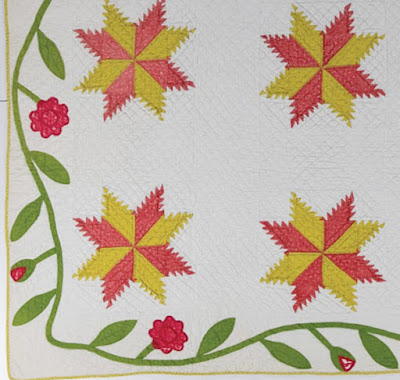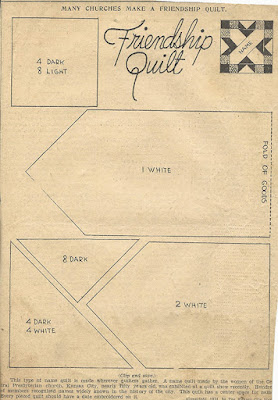Chrome orange and chrome yellow were two commonplace dyes
used in American quilts.
International Quilt Museum Collection
Quilt with chrome yellow by the Dobson sisters of Indiana
After 1840 or so chrome orange and yellow in prints and plains were popular for piecing and a favorite accent to the reds and greens of appliqué florals.
Quilt about 1900 from the Alamance County
Historical Society in North Carolina
Towards the end of the nineteenth century and into the twentieth, quiltmakers in parts of Pennsylvania and the Southern United States considered the color the perfect background for appliqué and pieced designs.
Pennsylvania quilt from an online auction
The chrome dyes are quite colorfast. Light rarely affects them.
But they react to the acid/alkalai balance in laundering.
Acids in the water or a spill can discharge the orange leaving a pale yellow green as in the above quilt.
They can crock, rub off onto other fabrics.
And gasses in the air can turn them brown.
"Gases such as carbon monoxide and carbon dioxide, Chlorine, sulfur or sulfur dioxide could potentially have an impact."
I would guess that burning coal produces sulfur in the air. We don't use chromes any more for dyeing. The minerals are too dangerous to workers. And they are not that useful for dating quilts as we see them from about 1840-1930. But they are certainly a visual delight.
International Quilt Museum Collection
Kathlyn Sullivan collection of North Carolina quilts
Here's a sheet on chrome orange changing color.
And more posts on the chromes:
http://barbarabrackman.blogspot.com/2009/12/chrome-orange.htmlhttp://barbarabrackman.blogspot.com/2010/02/chrome-orange-chrome-yellow.html
http://barbarabrackman.blogspot.com/2011/09/chrome-orange-background-and-accent.html











































.jpg)


.jpg)
.jpg)

.jpg)














.jpg)

.jpg)









